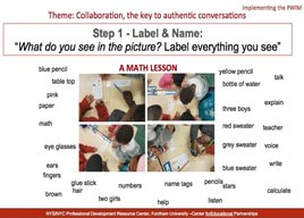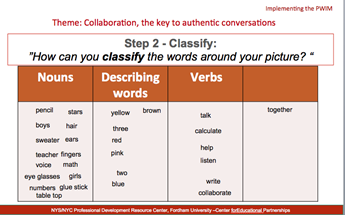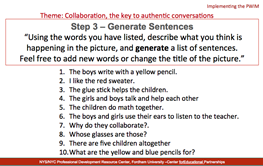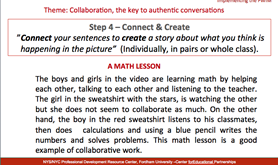|
Vocabulary lies at the heart of communication, reading comprehension and content learning. In today’s knowledge – based and global society helping students express themselves more precisely, sharpens their communication skills and supports their academic learning, even when writing short text messages that incorporate symbols and/or emojis. In this article, we share the Picture Word Inductive Model (PWIM), a strategy that is embraced by all teachers: from Early Childhood to Secondary grades. The PDRC Team is offering hands-on professional development on this model this coming February, as part of the Learner-Centered Writing Strategies for Communication and Learning series. We encourage you to try it out with your students and then share your experience during the training as we go deeper into students-centered writing strategies. What is the Picture Word Inductive Model? Designed by Joyce and Calhoun (1) in 1998 for early literacy instruction, it has been found to be an effective protocol for learners at all grade levels because it builds on the brain’s natural curiosity to seek out and remember patterns. Calhoun defined it as “an inquiry-oriented language arts strategy that uses pictures containing familiar objects and actions to elicit words from children’s listening and speaking vocabularies,” (Calhoun, 1999).  Steps to Implementing the PWIM The teacher chooses a picture or a short video based on topic and relevance and implements the protocol in four sequential steps. Step 1- Label Students label everything they see in the picture (and hear in a video clip). As a class, in pairs or in small groups, students read, review the words, and add new ones. Then, they name the picture.  Step 2 - Classify Students classify the words, working in pairs or triads. They can classify the words by grammatical function, type of action, shapes, colors, content area, etc. The teacher leads the group to read and review the characteristics of each type of word. Step 3- Describe Students describe what they think is happening in the picture and generate sentences using their word list. The word list often becomes a trigger for new words, words that are necessary to form complete sentences. Step 4 - Connect Once the students have a list of sentences and a title for their picture, they use all these sentences to create/write a story about what they think is happening in the picture (Individually, in pairs or whole class). Here again, the sentences are used to the extent that they support the story development; teachers encourage new ideas and new sentences so as to create an interesting story. Students share their stories with the support of the teacher, when necessary. For Early Childhood teachers, the PWIM is a must strategy for language development, but it is also a must instructional practice for many other teachers. English teachers use the PWIM to help students develop vocabulary, understand grammar, and write stories using the 4 language components of listening, speaking, reading, writing, as well as retelling. The intuitive approach to language learning engages second language learners in the use of their new language. Thus, the protocol is used extensively in the ESL and WL classrooms. Similarly, Social Studies, Mathematics, Science and Arts teachers use the PWIM protocol to introduce and engage students in practicing academic language and content specific expressions in a supportive and collaborative manner. We look forward to seeing you at the Webinar on February 9, 2022. Registration link: bit.ly/pdrcleadershipseries 1. Calhoun, E. F. (1999). Teaching beginning reading and writing with the picture word inductive model. Alexandria, Virginia: Association for Supervision and Curriculum Development.
0 Comments
Your comment will be posted after it is approved.
Leave a Reply. |
Archives
January 2024
Categories
All
|


